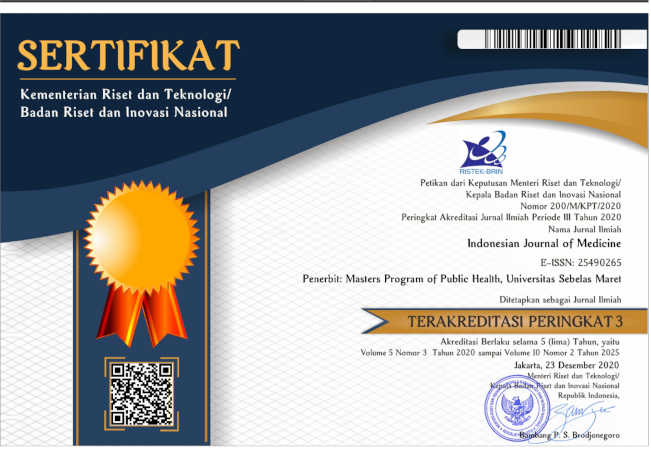Association of Antiretroviral Regimens and CD4 Counts with Dyslipidemia in HIV Patients: Implications for Metabolic Management
DOI:
https://doi.org/10.26911/theijmed.2025.10.1.797Abstract
Background: Dyslipidemia, a key risk factor for cardiovascular disease, is prevalent among people living with HIV/AIDS receiving antiretroviral therapy. This study aims to evaluate the impact of different ART regimens on lipid profiles in HIV patients and identify regimens with better outcomes in lipid profile levels.
Subjects and Method: An observational study was conducted from June to August 2024 at Dr. Saiful Anwar Regional General Hospital, Malang, Indonesia. Participants were recruited using consecutive random sampling, including HIV patients on ART for at least three months. Independent variables included ART regimens and CD4 counts, while the dependent variable was dyslipidemia status. Data were collected via demographic forms, medical record reviews, and lipid profile analysis. Statistical analysis was performed using chi-square and t-tests, with significance set at p < 0.05.
Results: Of the 110 participants, 38.2% were identified with dyslipidemia. The highest dyslipidemia rates were observed in patients using the Duviral Alluvial regimen (80.0%), followed by Duviral Neviral (71.4%). Newer regimens, TLD and TLE, were associated with lower dyslipidemia rates (31.3% and 36.0%, respectively; p = 0.045). A significant association was also noted between dyslipidemia and CD4 counts, with dyslipidemic patients showing higher mean CD4 counts (560.29 cells/μL) compared to non-dyslipidemic individuals (378.40 cells/μL; p = 0.009).
References
Ahmed M, Ahmed M, Mital D, Ahmed MH (2022). Chapter 36 - Management of hypercholesterolemia in individuals living with HIV/AIDS. Academic Press. 999–1020. https://doi.org/-10.1016/B978-0-323-85857-1.00006-7.
Husain NEO, Ahmed MH (2015). Managing dyslipidemia in HIV / AIDS patients : challenges and solutions. HIV AIDS (Auckl). 7: 1–10. https://doi.org/10.-2147/HIV.S46028.
Currier J (2023). Epidemiology of cardio-vascular disease and risk factors in patients with HIV. Wolters Kluwer. 118(2):e29–e35. https://doi.org/10.1161/CIRCULATIONAHA.107.189624
Dai L, Liu A, Zhang H, Wu H, Zhang T, Su B, Shao Y, et al., (2019). Impact of lopinavir/ritonavir and efavirenz-based antiretroviral therapy on the lipid profile of Chinese HIV/AIDS treatment-naïve patients in Beijing: A retrospective study. Current HIV Research, Netherlands. 17(5):324–334. https://doi.org/10.2174/157016-2X17666191025115508.
Fahmi I, Yona S (2019). Cardiovascular disease risk in HIV-positive popula-tions in Indonesia: A literature re-view. Indonesian Journal of Nursing and Health Sciences. 2(1): 93–100. https://www.semanticscholar.org/paper/Cardiovascular-disease-risk-in-HIV-Positive-in-A-Fahmi-Yona/-28be32fc00558804a13d6d818-59ad92b71690d9e
Grinspoon S, Carr A (2005). Cardiovascular risk and body-fat abnormalities in HIV-infected adults. N Engl J Med. 352(1): 48–62. https://doi.org/10.10-56/NEJMra041811.
Jellinger PS, Handelsman Y, Rosenblit PD, Bloomgarden ZT, Fonseca VA, Garber AJ, Grunberger G, et al., (2017). American association of clinical endocrinologists and American college of endocrinology guidelines for management of dyslipidemia and prevention of cardiovascular disease. Endocr Pract. 23(2): 1–87. https://doi.org/-10.4158/EP171764.APPGL.
Khemla S, Meesing A, Sribenjalux W, Chetchotisakd P (2023). Lipid profiles of people with human immunodeficiency virus with dyslipidemia after switching from efavirenz to dolutegravir. Drug Target Insights. 17: 45–53. https://doi.org/10.33393/dti.202-3.2529.
Li X, Song X, Han Y, Qiu Z, Cao W, Li T (2023). Risk factors and longitudinal changes of dyslipidemia among Chinese people living with HIV receiving antiretroviral therapy. BMC Infectious Diseases. 23(1): 598. https://doi.org/10.1186/s12879-023-08587-0.
Lin CF, Chang YH, Chien SC, Lin YH, Yeh HY (2018). Epidemiology of Dyslipi-demia in the Asia Pacific Region. Int J Geront. 12(1): 2–6. https://doi.org/10.1016/j.-ijge.2018.02.010.
MacInnes A, Lazzarin A, Di Perri G, Sierra-Madero JG, Aberg J, Heera J, Rajicic N, et al., (2011). Maraviroc can improve lipid profiles in dyslipidemic patients with HIV: results from the MERIT trial. HIV Clin Trials. 12(1): 24–36. https://doi.org/10.1310/hct1-201-24.
Martini S, Pisaturo M, Russo A, Palamone MG, Russo MT, Zollo V, Maggi P, et al., (2023). Evaluation of lipid profile and intima-media thickness in anti-retroviral-experienced HIV-infected patients treated with protease inhi-bitor-based regimens versus protease inhibitor-sparing regimens. Patho-gens. 12(7):925. https://doi.org/10.-3390/pathogens12070925.
Meena DS, Rai M, Singh SK, Tapadar J, Kumar D (2020). Metabolic changes in the patients on second-line highly active antiretroviral therapy (HAART): A prospective cohort study from north India. J Fam Med Primary Care. 9(3):1550-1554. https://doi.org/10.4103/-jfmpc.jfmpc_1208_19
Mosca S, Araújo G, Costa V, Correia J, Bandeira A, Martins E, Mansilha H (2022). Dyslipidemia diagnosis and treatment: Risk stratification in children and adolescents. J Nutr Metab. https://doi.org/10.1155/2022-/4782344.
Muya E, Kamuhabwa A (2019). Compa-rative assessment of the magnitude of hyperlipidemia in hiv-infected pati-ents receiving lopinavir/r- and ataza-navir/r-based antiretroviral drugs. J Int Assoc Provid AIDS care. 18: 232-5958219841908. https://doi.org/10.-1177/2325958219841908.
Ombeni W, Kamuhabwa AR (2015). Lipid Profile in HIV-Infected Patients Using First-Line Antiretroviral Drugs. J Int Assoc Provid AIDS Care. 15(2): 164–171. https://doi.org/10.1177/23259574-15614642.
Papantoniou E, Arvanitakis K, Markakis K, Papadakos SP, Tsachouridou O, Popovic DS, Germanidis G (2024). Pathophysiology and Clinical Management of Dyslipidemia in People Living with HIV: Sailing through Rough Seas. Life(Basel). 14(4):449. https://doi.org/10.3390/-life14040449.
Pefura Yone EW, Betyoumin AF, Kengne AP, Kaze Folefack FJ, Ngogang J (2011). First-line antiretroviral therapy and dyslipidemia in people living with HIV-1 in Cameroon: a cross-sectional study. AIDS Res Ther. 8:33. https://doi.org/10.1186/1742-6405-8-33.
KRI (2019). Pedoman Nasional Pelayanan Kedokteran Tatalaksana HIV. Jakarta.
Riddle TM, Schildmeyer NM, Phan C, Fichtenbaum CJ, Hui DY (2002). The HIV protease inhibitor ritonavir increases lipoprotein production and has no effect on lipoprotein clearance in mice. J Lipid Res. 43(9): 1458–1463. https://doi.org/10.1194/jlr.-M200129-JLR200.
Sarkar S, Brown T (2023). Lipid Disorders in People with HIV. In: Feingold KR, Anawalt B, Blackman MR, et al., editors. Endotext [Internet]. South Dartmouth (MA): MDText.com, Inc. Available from: https://www.ncbi.-nlm.nih.gov/books/NBK567198/.
Sprinz E, Lazzaretti RK, Kuhmmer R, Ribeiro JP (2010). Dyslipidemia in HIV-infected individuals. Braz J Infect Dis. 14(6): 575–588. https://-doi.org/10.1016/S1413-8670(10)701-15-X.
Vos AG, Venter WDF (2021). Cardiovascular toxicity of contemporary antiretroviral therapy. Curr Opin HIV AIDS. 16(6): 286-291. https://doi.org/10.1097/COH.000-0000000000702
World Health Organization. (2023), “Fact Sheet : HIV and AIDS”, World Health Organization.











